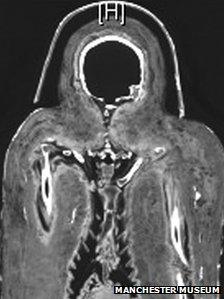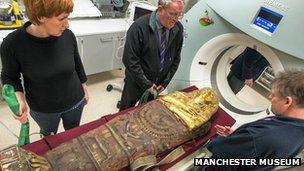Scientists to scan Perth mummy 3,000 years after death
- Published
The scans will be the first investigations into the mummy's secrets
Curators at Perth's museum are sending a 3,000-year-old Egyptian mummy for CT scans and X-rays.
They hope investigations, by Manchester University and Manchester Children's Hospital, will reveal details about the mummy's life and death.
It is thought she could have been a priestess or princess, possibly in the ancient city of Thebes.

The scans reveal details of the diet and diseases of ancient Egyptians
The mummy has been in Perth's collection since it was donated by an Alloa museum which closed down.
It will be the first time any investigations have been carried out on Perth's mummy, though the museum did send a mummified ibis - a bird sacred to the ancient Egyptians - to Manchester last year.
The work is part of projects to draw up international databases of human and animal mummy remains.
The results tell scientists more about the diet ancient Egyptians enjoyed, as well as the diseases they suffered.
Similar scans on other mummies in Manchester's own collection have revealed that a number were anaemic, and that many had dental problems, possibly linked to eating bread that was full of sand.
Sometimes the results also uncover metal charms hidden within the mummy's bandages, which may have been thought to protect the dead in the after-life.
Dr Lidija McKnight, from the university's Centre for Biomedical Egyptology, said the main question would be "is there really a body in there?".
"Probably," she predicted, "because you can see bones and feet sticking out of the bandages.
"We know the coffin suggests it's a female, so we will check whether it really is a woman. If it's a man, then clearly something has gone awry at some stage over the years.
"We'll try and assess an age - was this an adult, a teenager, or a child? And we should get some suggestion of whether the person had suffered any diseases or injures."
The work is a continuation of a programme of study that began as long ago as 1908, when a mummy was carefully unwrapped in a Manchester lecture room.

Scanning Perth's mummy is part of a programme to draw up an international database
But the project means researchers can probe the mysteries of these preserved people, non-destructively.
That should help in the future, when decisions have to be made about the conservation of the mummy.
Dr McKnight said people were always curious about the mummies' secrets.
"People always want to know the cause of death. We don't usually see anything horrific, but that's not to say there won't be any clues to what they died of," she said.
"We quite often see signs of osteoporosis, or diseases associated with old age.
"And are there any amulets or jewellery incorporated within the bandages? We won't know until we have a look.
"We will also look to see how the body was mummified. Were internal organs left in, taken out altogether, or taken out and wrapped and then put back?
"Was the brain removed? That may depend on the period in which the body was mummified."
The research uses scanners at Manchester's Royal Children's Hospital, because they are not normally needed at night time. But Dr McKnight said the multi-disciplinary team would soon be hustled out, if there was an emergency.
She said "the living take precedence over the dead", so the project would not affect patient care in any way.
- Published18 July 2012
- Published10 February 2012